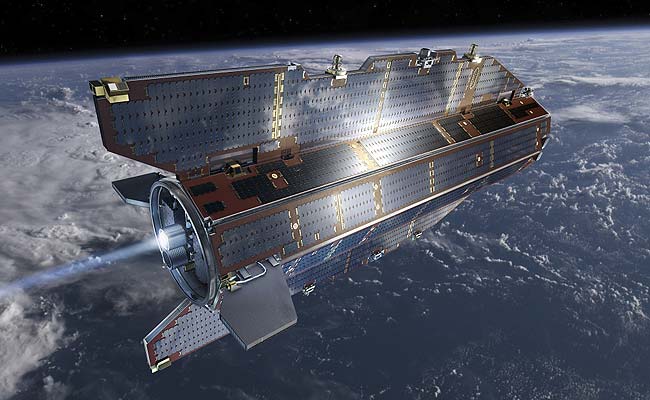In short, the European Space Agency's GOCE (Gravity Field and Steady-State Ocean Circulation Explorer) satellite was last orbited in extremely low altitude elliptical Low Earth Orbit (LEO) with perigee of 195 kilometres (121 mi) and apogee of 201 kilometres (125 mi) altitude above the sea-level. At that altitude, there is still some atmospheric pressure, albeit extremely tenuous, but given the satellite's velocity and surface area still enough to result in meaningful drag and decreasing its orbital velocity. Additionally, the Sun's increased activity during the last weeks resulted in increased particle density solar winds reaching the Earth through (flares and coronal mass ejections) and have somewhat increased the satellites rate of orbital decay due to increased atmospheric drag.

Artist's depiction of the European Space Agency's Gravity Field and Steady-State Ocean Circulation Explorer satellite in orbit.
GOCE is even an aerodynamically streamlined satellite to reduce that drag to minimum possible and require less of its propellants to constantly do orbital reboosts to increase its velocity and with it altitude, but since it ran out of its propellant (GOCE used Xenon ion propulsion thrusters powered by 1,300 W fixed solar panels), its orbit will slowly decay due to atmospheric drag and it will end its life falling towards the lower and denser atmosphere where it will presumably completely burn up.
These orbital reboosts are a standard procedure also for the International Space Station (ISS) that currently orbits at the altitude of 230 miles (370 km), and each new visiting spacecraft (such as today's Soyuz TMA-11M that was just launched from Baikonur Cosmodrome) lends it a hand with its own thrusters after the spacecraft has successfully docked with the station.
Some values and a graph of atmospheric pressure at LEO altitudes and beyond are listed on the Wikipedia page on International Standard Atmosphere. Quoting a Cornell University document on Simultaneous Orbit and Atmospheric Density Estimation for a Satellite Constellation (PDF):
For many satellites in low earth orbit (LEO), the largest dynamic
model uncertainty stems from atmospheric drag. Acceleration due to
atmospheric drag $a_D$ is related to atmospheric density $p$ by the
equation:
$$a_D = - {1\over2}({C_D{A_v(t)\over{m_s}}})\ {pv_r}^2e_v$$
where $C_D$ is a drag coefficient, $A_v(t)$ is the cross-sectional
area of the satellite in the direction of travel, $m_s$ is the total
spacecraft mass, $v_r$ is the velocity magnitude relative to the
ambient atmosphere, and $e_v$ is a unit vector in the relative
velocity direction. Uncertainty enters this equation in three ways.
First, the scalar product $({C_D{A\over{m_s}}})$, known as the inverse
ballistic coefficient, is generally uncertain and may be time-varying.
Second, the relative velocity may be uncertain, either because it has
not yet been estimated accurately or because the local wind does not
rotate perfectly with the Earth. Finally, atmospheric density is very
difficult to determine. Three basic paradigms exist for dealing with
drag uncertainty: It can be modeled, measured directly or indirectly,
or estimated in conjunction with satellite orbits.
And this is a calculated density and reference density vs. altitude graph for Circular Equatorial Orbit (Direct PDF download: Determination of Atmospheric Density in Low-Earth Orbit Using GPS Data, United States Naval Academy, John L. Young III):

Satellites orbited above any atmospheric drag like the ones in Geosynchronous (GSO) or Geostationary Orbit (GEO), usually communications satellites, however aren't disposed of by deorbiting them into the atmosphere where they could burn, but are placed in a graveyard or junk disposal orbit a few hundred kilometers above the GEO belt.

